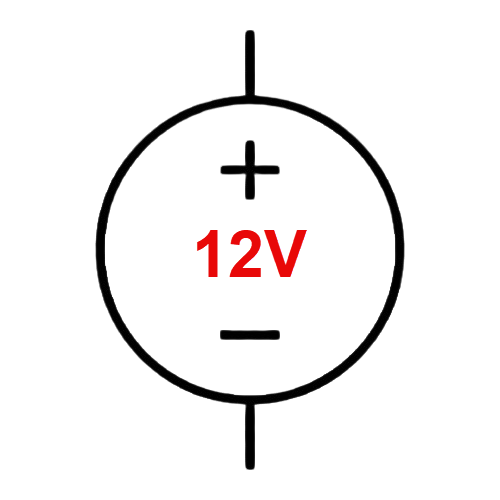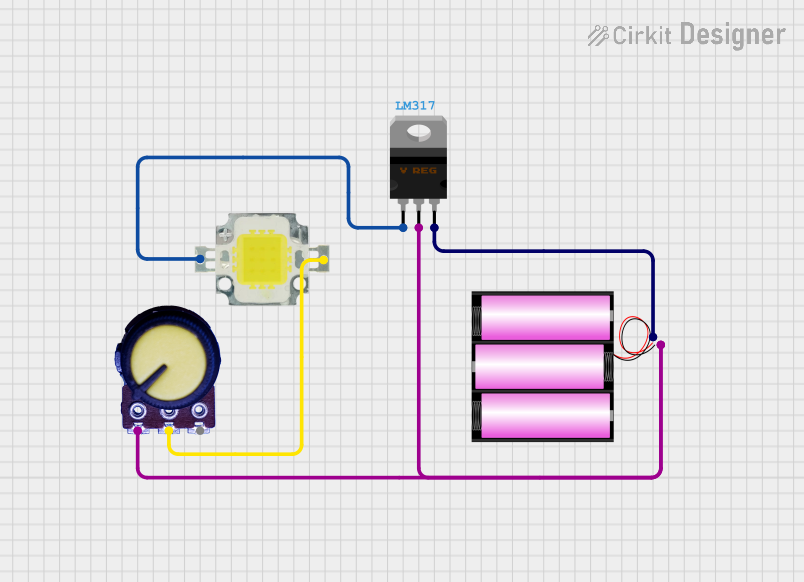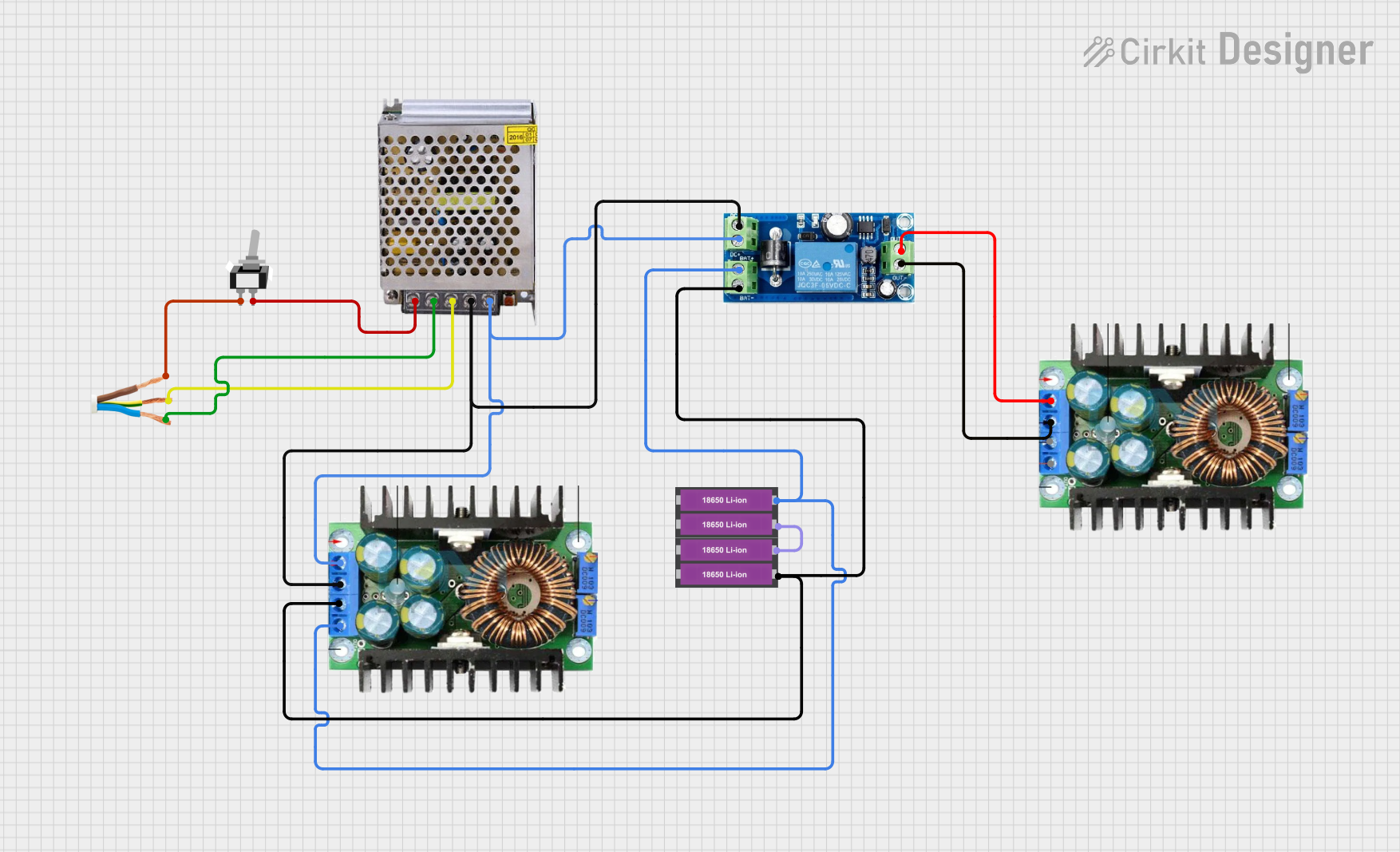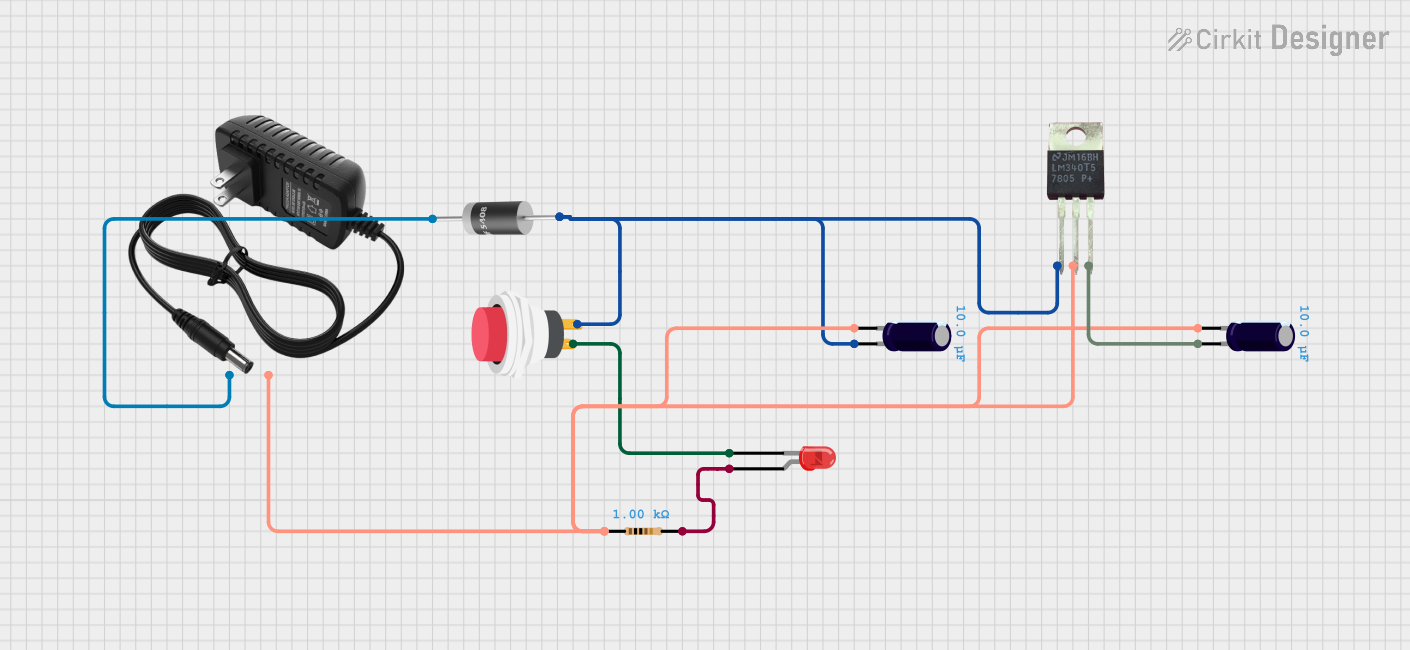
How to Use 12V DC Power Supply: Examples, Pinouts, and Specs

 Design with 12V DC Power Supply in Cirkit Designer
Design with 12V DC Power Supply in Cirkit DesignerIntroduction
The 12V DC Power Supply is a device designed to convert alternating current (AC) from the mains into a stable 12V direct current (DC) output. This component is widely used in powering electronic circuits, devices, and systems that require a reliable 12V DC input. It is an essential component in applications such as home automation, robotics, LED lighting, and powering microcontrollers or sensors.
Explore Projects Built with 12V DC Power Supply

 Open Project in Cirkit Designer
Open Project in Cirkit Designer
 Open Project in Cirkit Designer
Open Project in Cirkit Designer
 Open Project in Cirkit Designer
Open Project in Cirkit Designer
 Open Project in Cirkit Designer
Open Project in Cirkit DesignerExplore Projects Built with 12V DC Power Supply

 Open Project in Cirkit Designer
Open Project in Cirkit Designer
 Open Project in Cirkit Designer
Open Project in Cirkit Designer
 Open Project in Cirkit Designer
Open Project in Cirkit Designer
 Open Project in Cirkit Designer
Open Project in Cirkit DesignerCommon Applications and Use Cases
- Powering microcontrollers (e.g., Arduino, Raspberry Pi) and development boards
- Supplying power to LED strips, motors, and relays
- Charging 12V batteries
- Providing a stable power source for audio amplifiers and other electronic devices
- General-purpose use in DIY electronics projects
Technical Specifications
The following table outlines the key technical details of a typical 12V DC Power Supply:
| Parameter | Specification |
|---|---|
| Input Voltage | 100-240V AC, 50/60Hz |
| Output Voltage | 12V DC ± 5% |
| Output Current | Typically 1A to 10A (varies by model) |
| Power Rating | 12W to 120W (depending on current rating) |
| Efficiency | ≥ 80% |
| Ripple and Noise | ≤ 120mV |
| Operating Temperature | 0°C to 50°C |
| Protection Features | Overload, overvoltage, and short-circuit |
Pin Configuration and Descriptions
The 12V DC Power Supply typically has the following connections:
| Pin/Connector | Description |
|---|---|
| AC Input (L, N) | Live (L) and Neutral (N) terminals for AC input |
| Ground (GND) | Earth/ground connection for safety |
| DC Output (+) | Positive terminal for 12V DC output |
| DC Output (-) | Negative terminal (ground) for 12V DC output |
Some models may use barrel connectors or screw terminals for the DC output.
Usage Instructions
How to Use the 12V DC Power Supply in a Circuit
Connect the AC Input:
- Ensure the power supply is rated for your local mains voltage (e.g., 110V or 220V AC).
- Connect the Live (L) and Neutral (N) wires to the corresponding terminals on the power supply.
- If available, connect the Ground (GND) terminal to the earth wire for safety.
Connect the DC Output:
- Identify the positive (+) and negative (-) terminals of the DC output.
- Connect the positive terminal to the positive rail of your circuit and the negative terminal to the ground rail.
Power On:
- Plug the power supply into the mains socket and switch it on.
- Verify the output voltage using a multimeter before connecting sensitive devices.
Important Considerations and Best Practices
- Check the Current Rating: Ensure the power supply can provide sufficient current for your circuit. Exceeding the rated current may damage the power supply or cause it to shut down.
- Use Proper Wiring: Use wires with appropriate thickness to handle the current without overheating.
- Avoid Overloading: Do not connect devices that collectively draw more power than the supply's rated wattage.
- Ventilation: Ensure adequate airflow around the power supply to prevent overheating.
- Polarity: Double-check the polarity of the DC output before connecting it to your circuit to avoid damage.
Example: Connecting to an Arduino UNO
The 12V DC Power Supply can be used to power an Arduino UNO via its barrel jack. Below is an example of how to connect and use it:
- Connect the positive (+) terminal of the power supply to the center pin of the Arduino's barrel jack.
- Connect the negative (-) terminal to the outer sleeve of the barrel jack.
- Ensure the power supply provides a stable 12V DC output.
Sample Arduino Code
If you are powering an Arduino UNO with the 12V DC Power Supply, you can use the following code to blink an LED connected to pin 13:
// This code blinks an LED connected to pin 13 of the Arduino UNO.
// Ensure the Arduino is powered by the 12V DC Power Supply.
void setup() {
pinMode(13, OUTPUT); // Set pin 13 as an output
}
void loop() {
digitalWrite(13, HIGH); // Turn the LED on
delay(1000); // Wait for 1 second
digitalWrite(13, LOW); // Turn the LED off
delay(1000); // Wait for 1 second
}
Troubleshooting and FAQs
Common Issues and Solutions
No Output Voltage:
- Cause: The power supply is not connected to the mains or the input voltage is incorrect.
- Solution: Verify the AC input connections and ensure the mains voltage matches the power supply's input rating.
Output Voltage is Not 12V:
- Cause: The power supply is overloaded or faulty.
- Solution: Reduce the load and measure the output voltage again. If the issue persists, replace the power supply.
Power Supply Overheats:
- Cause: Insufficient ventilation or excessive load.
- Solution: Ensure proper airflow around the power supply and reduce the load if necessary.
Device Does Not Power On:
- Cause: Incorrect polarity or loose connections.
- Solution: Double-check the polarity of the DC output and ensure all connections are secure.
FAQs
Q1: Can I use a 12V DC Power Supply to charge a 12V battery?
A1: Yes, but ensure the power supply has a current-limiting feature or use a dedicated battery charger to prevent overcharging.
Q2: Is it safe to leave the power supply on for extended periods?
A2: Yes, as long as the power supply is not overloaded and has proper ventilation.
Q3: Can I use this power supply with a 5V device?
A3: No, you will need a voltage regulator or a step-down converter to safely power a 5V device.
Q4: What happens if I reverse the polarity of the DC output?
A4: Reversing the polarity can damage your circuit. Always double-check the connections before powering on.
By following this documentation, you can safely and effectively use a 12V DC Power Supply in your projects.